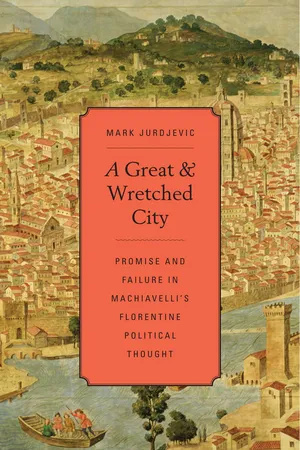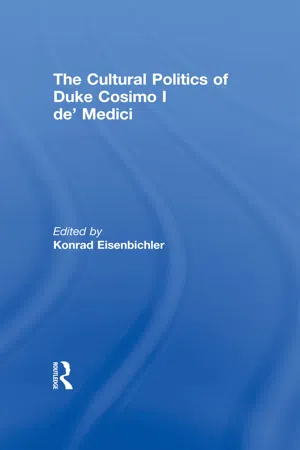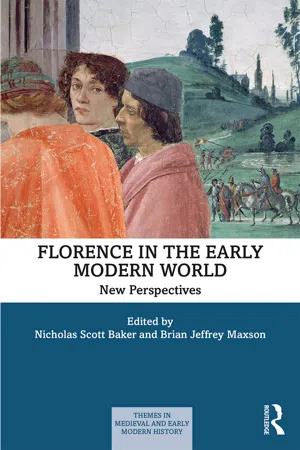History
Medici Family
The Medici family was a powerful and influential Italian dynasty that rose to prominence during the Renaissance period. They were known for their patronage of the arts, support of scholars, and significant contributions to the cultural and political landscape of Florence. The family produced several influential leaders, including popes and rulers, and played a key role in shaping the history of Italy.
Written by Perlego with AI-assistance
Related key terms
5 Key excerpts on "Medici Family"
- eBook - ePub
- Paul Strathern(Author)
- 2016(Publication Date)
- Pegasus Books(Publisher)
It is difficult to tell whether the political modesty of these two early Medici was instinctive, feigned, or simply a matter of clan loyalty, or even clan policy. Self-consciousness in the late fourteenth century was still firmly rooted in medieval mores: people tended to regard themselves as members of a family, rather than as individuals. According to such a way of thinking, these early Medici would naturally have sunk their individual political ambitions in the long-term ambitions of the family as a whole, accepting that political power would only be achieved by the family in more propitious times; meanwhile it was best to lay the foundations, firmly establishing the family and its wealth to an ever greater degree, in preparation. However, such foresight would appear to display an extremely well-developed sense of political ambition. Did the Medici harbour secret long-term ambitions for political power, or was their early accumulation of wealth merely an ambition in itself? From such a distance it is impossible to tell the secret machinations and plans of the Medici Family at this stage. Being a member of the Medici Family certainly helped Giovanni di Bicci, for shortly after the ciompi revolt the new head of the family business, his uncle Vieri de’ Medici despatched Giovanni to Rome where he was apprenticed to the local branch of Vieri’s bank. Familial ties always played their part in businesses, especially in banking where trust was so essential. Even so, Giovanni evidently had an aptitude for the business, because within a few years he was made a junior partner, and three years later he became manager of the Rome branch - eBook - ePub
The Medici Women
Gender and Power in Renaissance Florence
- Natalie R. Tomas(Author)
- 2017(Publication Date)
- Routledge(Publisher)
Chapter Three Medici MatronageIn his Zibaldone or commonplace book, Giovanni Rucellai, an eminent Florentine art patron, quoted the aphorism: 'Men are made to do two main things in this world: The first is to procreate: The second is to build'.1 Both these tasks were designed to ensure the continuation and the glorification of the patrilineage, and it explains why in his treatise on architecture Antonio Filarete conceptualised the patron as the father of a building and the architect as its mother, a gendered metaphor that emphasised the relatively more significant role of the assumed male patron in this process.2 Apart from the notable exception of Isabella d'Este, Marchioness of Mantua, many historians have also often assumed a male as patron of Renaissance culture. Indeed, it is only relatively recently that the cultural patronage of women of ruling families of the Northern courts of Renaissance Italy has been receiving much needed attention.3 Similarly, the Medici women have received equally little attention in the voluminous literature on Medici artistic and literary patronage, with the possible exception of a small amount of work on Lucrezia Tornabuoni's artistic and literary patronage and just recently on Alfonsina Orsini's patronage of art.4 But the surviving evidence suggests that even this literature underestimates the importance of the Medici women's cultural patronage. Their support for convent building in particular, as well as other forms of artistic and literary patronage, including projects of a more secular type, was intimately bound up with, and vital to, the success of broader Medici strategies for shoring up support for themselves and their regime in the immediate environs of the family palace as well as in towns and territories that were part of Florence's territorial state. After the accession of Cardinal Giovanni di Lorenzo de' Medici to the papal throne in 1513 as Pope Leo X, one could add Rome to this list as well. It was in Leo X's Rome that Alfonsina Orsini turned Rucellai's aphorism on its head by becoming a matron who built a palace, effectively engaging in what some historians have recently termed 'matronage' in their efforts to elucidate the visible differences and the similarities between men and women's cultural patronage.5 - eBook - ePub
- Mark Jurdjevic(Author)
- 2014(Publication Date)
- Harvard University Press(Publisher)
In a rare moment of class unity, three conspiracies—one by the nobles, another by those of middling wealth, and the third by the city’s proletariat—were simultaneously set in motion in 1343. The Medici were among the leaders of the third conspiracy, consisting largely of the city’s “working men,” and went on to play a key role in the expulsion of the duke. 35 The chaotic aftermath of his departure led directly to a state of civil war between the nobility and the people, caused by the stubborn unwillingness of the nobles to restrain their abusive and arrogant conduct. In this conflict, too, the Medici were among the leaders of the popular faction and were the first family to attack the nobles. 36 After fierce and sustained fighting, the people decisively defeated the nobles, leading Machiavelli, from the vantage point of the 1520s, to conclude that “the ruin of the nobles was so great and so humbled their party that never afterward did they have courage to take arms against the people; on the contrary, they steadily became more courteous and abject.” 37 The Medici are thus introduced in book 2 as a family from the ranks of the people with some degree of standing among the lower guilds and laborers in 1343. He continued to connect the family to the city’s lower class when they returned to his narrative thirty-five years later. Setting the stage for the Ciompi uprising, Machiavelli described the city’s increasing fragmentation into two rival factions in 1378, caused by rising hostility to the arrogant conduct of the Guelf elite - Konrad Eisenbichler(Author)
- 2017(Publication Date)
- Routledge(Publisher)
Through a knowledge of the assemblage of these and other works formerly located in the palazzo, Cosimo could have appreciated how the Medici had visually communicated a commitment to Florentine republicanism and unity of political intent within their party while simultaneously undermining that republicanism through the family’s manipulation of the city’s constitution and staving off the worst of their party’s discord through the visual imaging of David’s, Judith’s, and Hercules’ selfless triumph over factious pride. I would also propose that in receiving the Palazzo Medici and in conceiving it to whatever degree as a totality, Cosimo was additionally receiving and conceiving the material culture of his blood line, the visual corollary of Medicean political power. It is essential in understanding Cosimo to know that his parents were descended each from one of the two lines of the Medici Family. Through his father Cosimo claimed descent from the minor, cadet branch of Lorenzo ‘il Popolano’; through his mother, from the senior branch of Cosimo the Elder. As Janet Cox-Rearick demonstrates, the connection and descent from the senior branch – from Cosimo the Elder, Lorenzo the Magnificent, and Pope Leo X – was central to the political myth of Duke Cosimo and a mainstay of his visual imagery and propaganda. This was particularly evident in the ephemeral decoration of the Palazzo Medici courtyard for Cosimo’s wedding banquet of 1539. According to Cox-Rearick, ‘the themes of this decoration were the new duke’s relationship to his Medici ancestors, his blood legitimacy, and his predestined place in Medici history.’ 30 My suggestion is that the same sense of dynasty and destiny that found visual form in the 1539 decorations may also have conditioned Cosimo’s attitude as a receiving patron during his residency in the Palazzo Medici- eBook - ePub
Florence in the Early Modern World
New Perspectives
- Nicholas Scott Baker, Brian J. Maxson(Authors)
- 2019(Publication Date)
- Routledge(Publisher)
The Petraia frescoes spotlight the roles of Ferdinando I and Cosimo II played as grand masters of the Order of Santo Stefano, and the crucial importance of its maritime success and prowess during their reigns. In the one scene chosen to summarize their grand-ducal tenure, their connection to their military order, and the order’s maritime accomplishments, is celebrated as their greatest achievement. As such, they confirm the continuing impact of iconography tied to the order in shaping Medici ruling identity, even as the power and effectiveness of the order declined precipitously throughout the seventeenth century. At Lorenzo’s death in 1648, he willed the villa to his nephew, reigning Grand Duke Ferdinando II, its frescoed walls serving as a salient reminder of the accomplishments of his glorious forebears, chief among them the victories connected to the family’s crusading knighthood.In 1537, Cosimo I de’ Medici inherited an unstable, and at times, openly hostile city. By the time his son Ferdinando I attained the grand-ducal office in 1587, Medici rule in Tuscany was secure and the family had achieved a level of prestige on par with the other powers of Europe. Consequently, the visual language of grand-ducal identity and authority underwent a decisive iconographic shift over the course of the sixteenth century. Ferdinando no longer needed to direct his military might toward his fellow Tuscans. Instead, he embraced narratives of conquest tied to the Medici crusading order, explicitly Christian victories in which the battlefield was no longer Italian soil but the waters of the Mediterranean, positioning the Medici as part of a global crusade. He replaced Cosimo’s battles to subdue the dominio
Learn about this page
Index pages curate the most relevant extracts from our library of academic textbooks. They’ve been created using an in-house natural language model (NLM), each adding context and meaning to key research topics.




